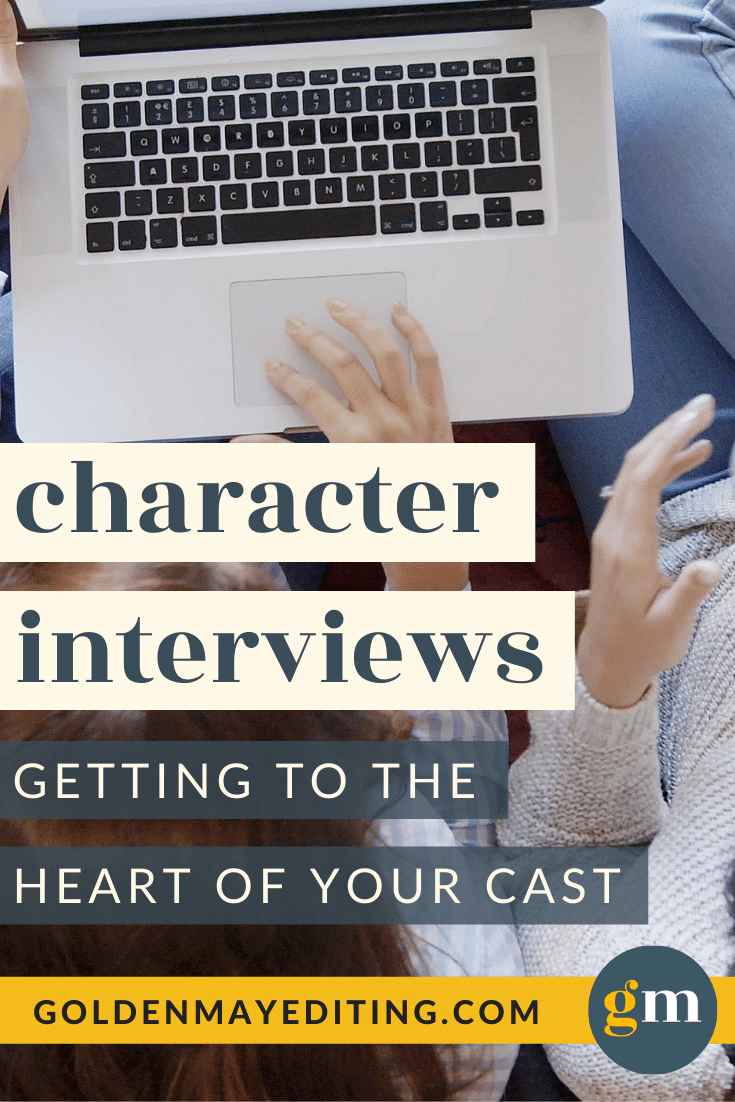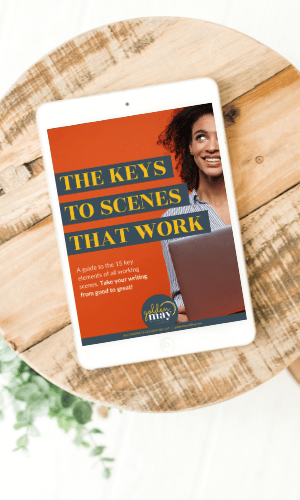This post was written by our friend Lewis Jorstad, an author and developmental editor who helps up-and-coming writers hone their writing craft over at The Novel Smithy. You can find him on Twitter, Pinterest, and Instagram. When he isn’t working on the next book in his Writer’s Craft series, you can find him playing old Gameboy games and sailing somewhere around the eastern half of the US. You can also check out his free ebook, The Character Creation Workbook, and grab a copy for yourself!
Creating a vibrant cast of characters is often easier said than done. For each character you write, you’ll need to consider everything from their personality to their relationships, history, fears, and more. With so many things to unpack, it’s no wonder that even the best writers can start to feel lost.
Enter character interviews!
If you’ve never heard of a character interview before, these are collections of prompts writers can use to better understand their cast—without all the confusion. Because the character development process is so complex, diving in on your own is often disorienting. Fortunately, with the right character interview questions in hand, you’ll have a great foundation for navigating this side of the writing craft.
The key word here is “right.” On the one hand, you don’t want your character interview to be too shallow, but you also can’t skip directly to the hardest hitting questions. Instead, you’ll want to strike a balance, slowly delving deeper into your characters as you learn more.
To help you out, I’ve created a series of forty-eight character interview questions, designed to get you thinking about your cast in a new way. Each question is sorted into one of five stages—so, without further ado, let’s start the interview!
#1: A Quick Introduction
First up, we should probably start off with a series of introductions.
This is where many character interviews stop short, but these are just the beginning for us. Rather than make up the entirety of our interview, these questions will help you get a feel for who your character is, based on things like their behavior, motivations, and mindset.
As you go through these questions, try to imagine your character going about their normal life:
- What is your character’s name?
- How old are they, and what is their most prominent feature?
- How do they move? What are their mannerisms and quirks?
- In a crowded room, how would they treat the people around them?
- What types of people do they hate? What types of people do they like?
- Where are they happiest? Where are they unhappy?
- Where do they want to be in five, ten, or twenty-five years?
- What gets them out of bed each morning?
- In their mind, what makes a good person? What is the secret to a good life?
- What is their greatest fear?
- Have they ever lied to someone they cared about, and why?
- What do they dream about at night?
- What do they want to do, achieve, change, or see before they die?
- What’s their dream job? (Yes, retirement counts!)
By the time you’ve finished this section, you should be able to describe your character’s personality in detail, along with a few key facts about them.
#2: Exploring Their History
From there, we can start delving deeper.
Here is where we’ll dig into your character’s perception of themselves and their world, also known as their identity. Identity is a somewhat complex topic, but for the sake of this interview, all you need to know is that identity comes in two main forms:
Internal Identity: Your character’s perception of themselves and their place in their world. This is usually a result of their past experiences.
External Identity: How others perceive your character based on their appearance, social status, or group affiliations. Typically, this will be out of your character’s control.
Meanwhile, you’ll also want to consider your character’s backstory. This backstory will tell you a lot about who they are and why—meaning it’s critical to understanding their story.
As you go through these questions, consider what’s going on beneath the surface of your character:
- Who do they think they are? How would they define themselves?
- What is the most important or influential event of their life up until this point?
- How has this event shaped their life?
- What is their best quality? What are they good at?
- What is their worst quality? What do they hate about themselves?
- What do they want others to know about them?
- What are they afraid of others finding out?
- Who is the most important person in their life, and why?
- What does that person think of them?
- Where do they fit within their society?
- Are they happy where they are?
By the end of this section, you should be able to describe your character’s identity in a few sentences, as well as one or two major events from their past.
NOTE: If you’d like to learn more about your character’s identity or backstory, these two articles should be a good starting place!
#3: Getting Technical
Next, it’s time to turn our attention to your character’s internal obstacle and your story point!
Their Internal Obstacle: A harmful belief that holds your character back throughout your story. Often called their inner struggle, lie, or wound, this belief prevents them from achieving their goals and resolving the core conflict of their story.
The Story Point: The lesson your character needs to learn in order to overcome their inner struggle, also called their truth. This stands in direct contrast to their harmful beliefs. Accepting this lesson is the final test of their journey.
These two pieces are the building blocks of your character’s transformation and are thus critical to writing a dynamic character. Without the internal conflict these pieces create, your character will have no reason to learn, change, and evolve throughout your story. Fortunately, their Internal Obstacle and your Story Point are mirror images—meaning if you know one, you can always find the other.
As you go through these questions, focus on the primary internal conflict your character will face:
- What internal obstacles will your character face throughout their story?
- What harmful beliefs do they hold, either about themselves or their world?
- How do these beliefs affect their behavior and actions?
- How will these beliefs prevent them from resolving your novel’s conflict?
- What lesson do they need to learn to overcome these beliefs?
- How will this lesson change their life and behavior?
- How can they prove they’ve accepted this lesson?
Once you’ve answered these questions, you should be able to describe your character’s Internal Obstacle and Story Point in a few sentences.
NOTE: Still unsure how your character’s internal conflict will shape their story? This article on the inner struggle (what Rachel and Emily call the Internal Obstacle) should help.
#4: Planning Their Journey
We’re approaching the end of our character interview, but before we wrap up, we need to delve deeper into your character’s transformation.
Dynamic characters are those who undergo significant change throughout their story, usually in the form of a character arc. These arcs follow your character as they face their Internal Obstacle and slowly realize their Story Point. If they’re to succeed, they’ll have to embrace that lesson, or risk devolving into a negative arc character.
As you go through these questions, think about how your character changes throughout your novel:
- Where are they, both mentally and physically, at the start of your novel?
- How does this compare to the end of your novel?
- Do they change for the better, or do they become a worse person as their story goes on?
- Why do they get involved with your plot in the first place?
- What decision sparks their involvement?
- What turning points do they experience throughout your story?
- What is their darkest moment?
By the time you’ve answered these questions, you should be able to describe your character’s arc in a few paragraphs.
#5: Finding Their Place
Last but not least, we’ve reached the final section of this character interview!
This is where we can finally turn our attention to your broader novel. After all, your character isn’t just a person—they’re also a part of your story. Because of this, you’ll need to understand not only how they grow and change, but also how they affect your plot, the rest of your cast, and your novel as a whole.
As you go through these questions, focus on where your character fits in your story:
- Who is this character?
- What role do they play in your novel?
- Are they a point of view character?
- Are they there to support another character, or are they your main focus?
- How will they affect your novel’s plot?
- What do they provide your story that no other character can?
By the time you’re done, you should have a complete character profile ready to add to your novel’s outline!
Putting Your New Character Interview to Use!
Overall, this character interview is a fantastic tool for developing your cast—not only now, but in the future too. You can repeat this process as many times as you’d like, and for every character you write. The key is getting into the mind of your interviewee. Don’t be afraid to shut your office door, turn on some gentle music, and really explore who this person might be.
When it’s all said and done, you’ll have a vibrant, dynamic character just begging to be written!
— Lewis







This is great, Lewis! Thank you! I love how many of these questions are so unique and unlike other character interview templates I’ve seen.